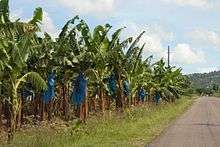Banana industry
The banana industry is an important part of the global industrial agrobusiness. About 15% of the global banana production goes to export and international trade for consumption in Western countries.[1] They are grown on banana plantations primarily in the Americas.[2]

Ecological impact
As is the case with all monocultures, the intensive agroindustrial methods for banana production have considerable environmental impact. Banana cultivation requires a large amount of pesticide (estimate: 35 lb/acre, 39 kg/ha) and can encourage ecosystem destruction through deforestation. Moreover, food miles and plastic packaging leave a large carbon footprint.[3][4][5]
Cash crop
In 2012 the volume of global gross banana exports reached a record high of 16.5 million metric tons (3.6×1010 lb), 1.1 million tonnes (or 7.3 percent) above 2011 level.[2] Bananas are the most popular fruit in the United States, with more consumed annually than apples and oranges combined.[6] In spite of the multitude of banana species across the world, even only taking into account the cultivated ones, industrial production is dominated by the Cavendish banana.
Spread of plant disease
Tropical Race 4 is thought to be distributed globally by soil-contaminated equipment from the multinational plantation owners.[7]
Companies
In 2013, five multinational fruit companies alone controlled 44% of the international banana trade:[8][9]
| Company | Country | Market share in 2013 [%] |
|---|---|---|
| Chiquita | U.S. | 13 |
| Fyffes | Ireland | 6 |
| Dole Food Company | U.S. | 11 |
| Fresh Del Monte Produce | U.S. | 12 |
| Noboa | Ecuador | 2 |
The market share of the above players decreased from 70% in 2002 to about 44% in 2013. This decline in market power has been attributed to a couple of reasons. In the past, multinational companies owned a large number of plantations in Central and South America and other banana-producing regions. Since the 1980s they have divested a large share of their own production, replacing it with greater purchases from independent producers. For example, Chiquita has decreased the number of its plantations in Central America. Fyffes used to own plantations in Jamaica, Belize and the Windward Islands, but withdrew from production and switched to purchasing its bananas through contracts with producers. The disengagement from production was partly caused by legal and economic problems at the plantation level, but also reflects the change in market power along the banana value chain.[10]
Along the global banana supply chain major supermarket chains in the US and EU have gained market power over the big producers in the 21st century as they dominate the retail market and increasingly purchase from smaller wholesalers or directly from growers.
Production and export
| Country | Bananas | Plantains | Total |
|---|---|---|---|
| 29.1 | 29.1 | ||
| 13.1 | 13.1 | ||
| 5.8 | 3.1 | 8.9 | |
| 6.5 | 0.6 | 7.1 | |
| 7.0 | 7.0 | ||
| 6.8 | 6.8 | ||
| 2.0 | 3.5 | 5.5 | |
| 1.2 | 4.3 | 5.5 | |
| 0.6 | 3.7 | 4.3 | |
| 0.09 | 4.0 | 4.1 | |
| 3.8 | 0.3 | 4.1 | |
| 113.3 | 35.1 | 148.4 | |
| Source: FAOSTAT of the United Nations[11] Note: Some countries produce statistics distinguishing between bananas and plantain production, but four of the top six producers do not, requiring comparisons using the total for bananas and plantains combined. | |||
In 2016, world production of bananas and plantains was 148 million tonnes, led by India and China with a combined total (only for bananas) of 28% of global production (table). Other major producers were the Philippines, Ecuador, Indonesia, and Brazil, together accounting for 20% of the world total of bananas and plantains (table).
As reported for 2013, total world exports were 20 million tonnes of bananas and 859,000 tonnes of plantains.[12] Ecuador and the Philippines were the leading exporters with 5.4 and 3.3 million tonnes, respectively, and the Dominican Republic was the leading exporter of plantains with 210,350 tonnes.[12]
See also
- Fruit production
- Banana republic
References
- http://www.fao.org/faostat/en/#data/TP
- "BANANA MARKET REVIEW and BANANA STATISTICS 2012-2013" (PDF). FAO Intergovernmental Group on Bananas and Tropical Fruits.
- "The Human and Environmental Impact of Bananas". 2012.
- http://business-ethics.com/2010/06/19/2440-banana-industrys-impact-on-rainforests/
- "Archived copy". Archived from the original on 2015-06-18. Retrieved 2016-06-16.CS1 maint: archived copy as title (link)
- "Frequently Asked Questions About Bananas". Chiquita. 2014. Archived from the original on 2016-06-26. Retrieved 2016-06-16.
- "Tally me banana - How the global banana industry is killing the world's favorite fruit". Quartz.
- http://www.bananalink.org.uk/the-problem-with-bananas
- "The Changing Role of Multinational Companies in the Global Banana Trade" (PDF). FOOD AND AGRICULTURE ORGANIZATION OF THE UNITED NATIONS. 2014.
- http://www.fao.org/docrep/019/i3746e/i3746e.pdf
- "Banana and plantain production in 2016, Crops/Regions/World list/Production Quantity (pick lists)". UN Food and Agriculture Organization, Corporate Statistical Database (FAOSTAT). 2017. Retrieved 6 January 2018.
- "Banana and plantain exports in 2013, Crops and livestock products/Regions/World list/Export quantity (pick lists)". UN Food and Agriculture Organization, Corporate Statistical Database (FAOSTAT). 2017. Retrieved 6 January 2018.